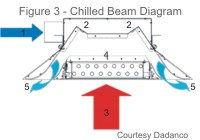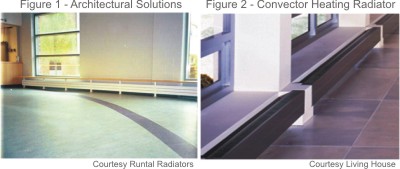
This Won’t Hurt
Chilled beams and radiant heat may stoke images of sticking your tongue to a frozen pipe in the northland; and searing heat like we’ve had this summer on numerous occasions, where pavement, brick walls, automobiles, and even what used to be a lawn, roasts mammals to their limits and even birds pant like dogs.
Chilled beams and radiant heat actually provide comfortable, quiet, cool sea breezes and toasty, warm comfort like the sun on a cool October day – and with fantastic energy efficiency.
Carrots, Not Sticks
Since Willis Carrier developed cooling for large buildings, and since the development of fluorescent lighting and hermetically sealed building designs, heating and cooling systems have been dominated by the stick rather than the carrot. Virtually all buildings with heating and cooling use the stick to force air through buildings, sometimes in huge volumes, at high pressure, and over long distances. This requires a lot of fan power, generates flow noise, requires complex control, which is typically poorly implemented, and vast quantities of control devices like electric valve and damper actuators, and the valves and dampers themselves.
Air will move itself with no external force (stick) whatsoever, if you treat it properly (carrot). That is correct. It isn’t magic. The same forces that drive our weather can move air in a building quietly and with no fans! Warm air rises. Cool air sinks. It’s that simple.


Location, Location, Location
Heating and cooling loads occur at locations where excess heat is lost and gained, respectively. Spaces adjacent to exterior walls almost always fit this bill, but so do internal areas with heat-generating equipment like copy machines or other large equipment. For optimal comfort, oppose the heat loss or gain right where it is occurring. Radiant heat can be supplied with numerous alternatives and a range of costs. It can be invisible in the floor, somewhat more visible, but architecturally appealing on the wall (Figure 1), or cheaper but effective (Figure 2).
Chilled beams do not look like a beam at all, in my opinion. They look more like a lighting fixture with a cooling coil and piping connections rather than light bulbs and wire for power. As shown in Figure 3, warm air rises (3), to the cooling coil (4) and in this type of chilled beam, ventilation air (1) from a small central energy recovery ventilator supplying fresh air entrains the warm air to enhance flow.
Combined with dedicated outdoor air systems discussed in past briefs, chilled beam and radiant heat offer greater system efficiency – much lower fan power, quiet, comfort, precision ventilation control, and efficient chilled water and hot water heating, to just barely get started.




